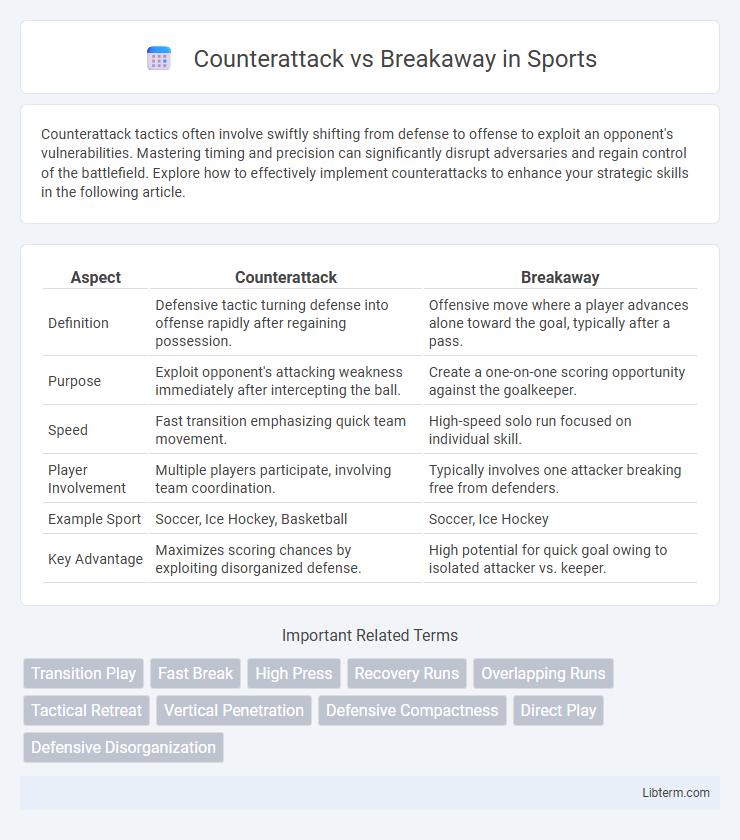Counterattack tactics often involve swiftly shifting from defense to offense to exploit an opponent's vulnerabilities. Mastering timing and precision can significantly disrupt adversaries and regain control of the battlefield. Explore how to effectively implement counterattacks to enhance your strategic skills in the following article.
Table of Comparison
| Aspect | Counterattack | Breakaway |
|---|---|---|
| Definition | Defensive tactic turning defense into offense rapidly after regaining possession. | Offensive move where a player advances alone toward the goal, typically after a pass. |
| Purpose | Exploit opponent's attacking weakness immediately after intercepting the ball. | Create a one-on-one scoring opportunity against the goalkeeper. |
| Speed | Fast transition emphasizing quick team movement. | High-speed solo run focused on individual skill. |
| Player Involvement | Multiple players participate, involving team coordination. | Typically involves one attacker breaking free from defenders. |
| Example Sport | Soccer, Ice Hockey, Basketball | Soccer, Ice Hockey |
| Key Advantage | Maximizes scoring chances by exploiting disorganized defense. | High potential for quick goal owing to isolated attacker vs. keeper. |
Understanding Counterattack: Definition and Purpose
Counterattack is a tactical response in sports or military strategy where a defending party quickly transitions to offense immediately after thwarting an opponent's attack. Its primary purpose is to exploit the opponent's temporary disorganization and gain a positional or momentum advantage. Unlike a breakaway, which emphasizes speed and individual effort, counterattacks rely on coordinated team movements and strategic timing to maximize effectiveness.
What is a Breakaway in Sports?
A breakaway in sports refers to a situation where an offensive player gains a clear advantage by outrunning or outmaneuvering defenders, often creating an open opportunity to score. This is commonly seen in hockey and soccer, where the player faces the goalkeeper or defense without immediate obstruction. Unlike a counterattack, which involves a quick transition after regaining possession, a breakaway highlights a direct, high-speed offensive move toward the goal.
Key Differences Between Counterattack and Breakaway
Counterattack and breakaway differ primarily in timing and intent: a counterattack is a responsive defensive strategy launched immediately after an opponent's attack to regain control and momentum, while a breakaway involves a sudden offensive break from the defensive zone aiming to quickly exploit space and score. In counterattacks, the emphasis lies on using the opponent's aggression to create scoring opportunities, whereas breakaways focus on speed and isolation to outmaneuver defenders. Key statistical metrics distinguishing these maneuvers include speed, spatial positioning, and recovery time during transitions in sports like hockey and soccer.
Strategic Importance of Counterattacks
Counterattacks hold strategic importance by exploiting an opponent's overextension and creating opportunities to regain momentum swiftly. They serve as a powerful tool to destabilize the opposition's attack, forcing them into defensive positions and opening gaps for scoring chances. Effective counterattacks rely on rapid transition play, precise passing, and player positioning to capitalize on defensive vulnerabilities during a breakaway.
Tactical Advantages of Breakaway Situations
Breakaway situations offer significant tactical advantages by creating numerical superiority and exploiting defensive disorganization, allowing the attacking team to transition quickly from defense to offense with high-speed, direct attacks. Players in breakaways benefit from more space and time to make decisions, increasing the likelihood of successful goal-scoring opportunities due to reduced defensive pressure. This tactical edge often forces defenders into reactive positions, disrupting their shape and increasing the probability of defensive errors.
Timing and Execution: Counterattack vs. Breakaway
Counterattacks require precise timing by capitalizing on an opponent's offensive mistakes immediately after a turnover, demanding quick transitions and rapid decision-making from players. Breakaways rely on individual speed and skill, creating one-on-one situations that often result from a sudden gap in defensive coverage. Effective execution in counterattacks hinges on coordinated team movement and exploiting numerical advantages, whereas breakaways depend more on individual player agility and finishing ability under pressure.
Psychological Impact on Opponents
Counterattack strategies provoke uncertainty and hesitation in opponents by exploiting their aggressive moves, often causing a shift from offense to defense that disrupts their game plan. Breakaway tactics trigger fear and urgency, forcing defenders into high-pressure situations where anxiety can lead to mistakes and lapses in concentration. Both approaches leverage psychological pressure to destabilize opponents, but counterattacks manipulate hesitation while breakaways intensify stress through swift, decisive actions.
Training Drills for Counterattack Mastery
Training drills for counterattack mastery emphasize rapid transition exercises that build speed and decision-making under pressure. High-intensity interval drills simulate breakaway scenarios, improving players' ability to regain possession quickly and launch effective counterattacks. Incorporating reactive agility drills enhances anticipation and positioning, crucial for exploiting opponents' vulnerabilities during counterattacks.
Developing Effective Breakaway Strategies
Developing effective breakaway strategies requires precise timing and spatial awareness to exploit defensive vulnerabilities during transitions. Key tactics include quick decision-making, leveraging speed, and maintaining optimal spacing to outmaneuver defenders and create scoring opportunities. Incorporating patterns like isolating defenders or utilizing overlaps enhances the likelihood of successful breakaways in competitive play.
Choosing the Right Approach: Counterattack or Breakaway?
Choosing the right approach between counterattack and breakaway depends on situational factors such as the opponent's positioning and your team's tactical strengths. Counterattacks exploit an opponent's overcommitment by quickly transitioning defense into offense, often leveraging speed and anticipation after intercepting the ball. Breakaways focus on fast, direct attacks from deep positions, emphasizing individual speed and ball control to bypass defenders and create scoring opportunities.
Counterattack Infographic

 libterm.com
libterm.com